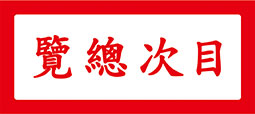
Portrait of Koxinga (鄭成功)
This year is the 110th year of the Republic of China, it is also the 360th anniversary of the recovery of Taiwan by Koxinga. Chinese mark history by a 60 year calendar cycle, known as chia-tzu (甲子), hence 360 year is also six calender cycles, or six chia-tzu , which makes this year’s anniversary additionally significant. On 29th April, 360 years ago, during the Southern Ming dynasty, in the 15th year of the reign of Yung-li (永曆) emperor 1661, Koxinga commanded a combined army and navy of 25,000 men, left Fukien province on hundreds of ships, and landed in Luermen harbour in Tainan, Taiwan. At that time, Taiwan was colonized by the Netherlands, the preeminent maritime power of the second half of the 17th century. Their stronghold was Fort Zeelandia in Tainan. Koxinga laid siege to Fort Zeelandia for nine months, ended with the surrender of the Dutch force led by governor Frederick Coyett. This was the first battle between China and a western power in modern history. Fort Zeelandia is now renamed Anping Old Fort.

Bird’s eye view of Fort Zeelandia
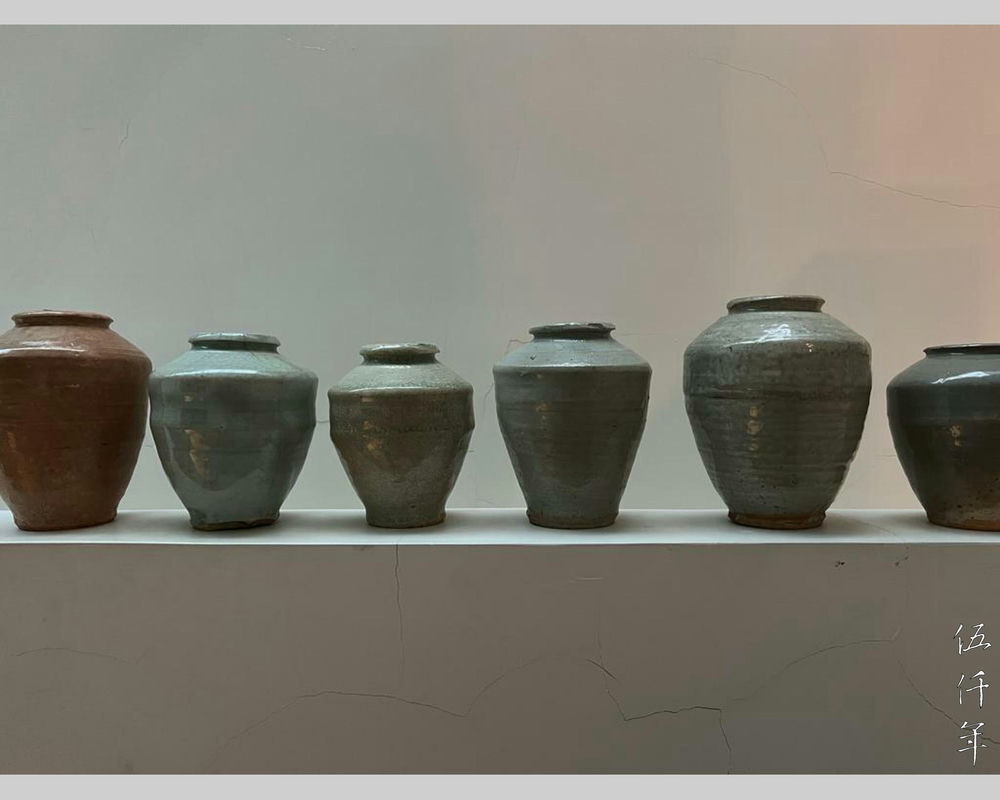
A collection of Anping vessels
A large number of ceramic containers have been excavated around Anping Old Fort. They come in slightly different shapes and sizes. It is widely believed that these containers were made to hold gunpowder, and used as grenades by Koxinga’s force. Art connoisseurs of later generations cherish them for their simple forms and colours, and the connotation of heroism. They are called Anping vessels.
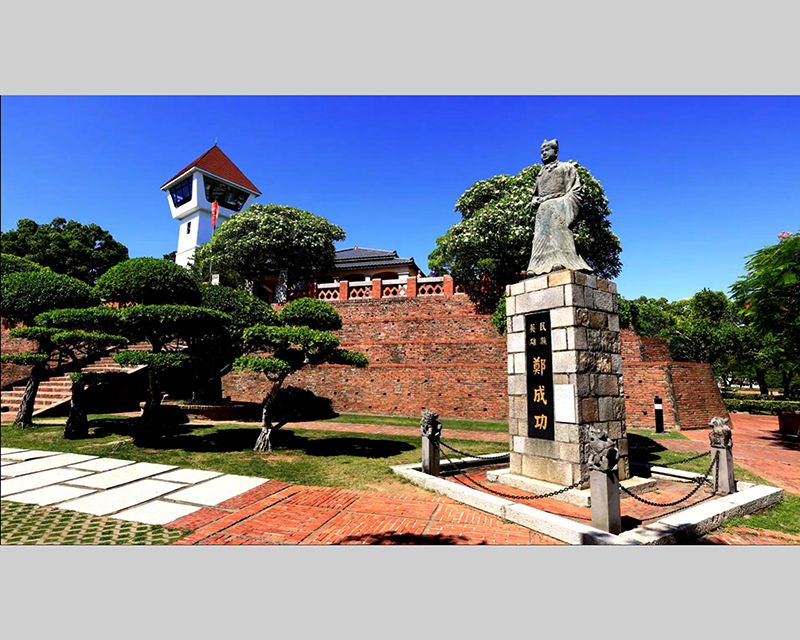
View of Anping Old Fort
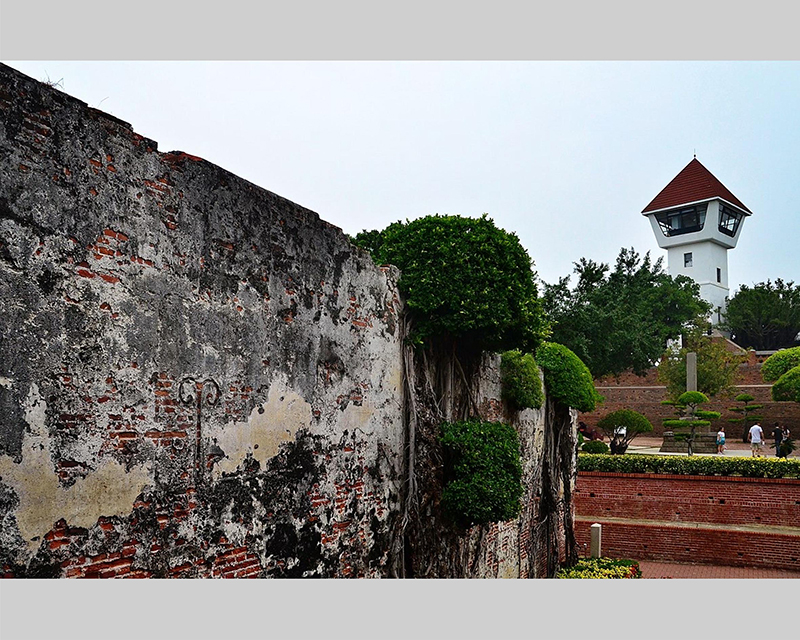
View of Anping Old Fort
Why was Fort Zeelandia renamed Anping Old Fort? Koxinga was born in the 4th year of the reign of T’ien-ch’i (天啟) 1624, in Hirado, Hizan Province, Japan. His father was Cheng Chih-lung (鄭芝龍), the mother T’ien-ch’uan (田川). Koxinga, whose real name was Cheng Ch’eng-kung (鄭成功), returned to China at the age of seven, and lived in Anping village in Fukien province. To invoke his childhood memory of Anping village, he renamed Fort Zeelandia Anping Village Fort.
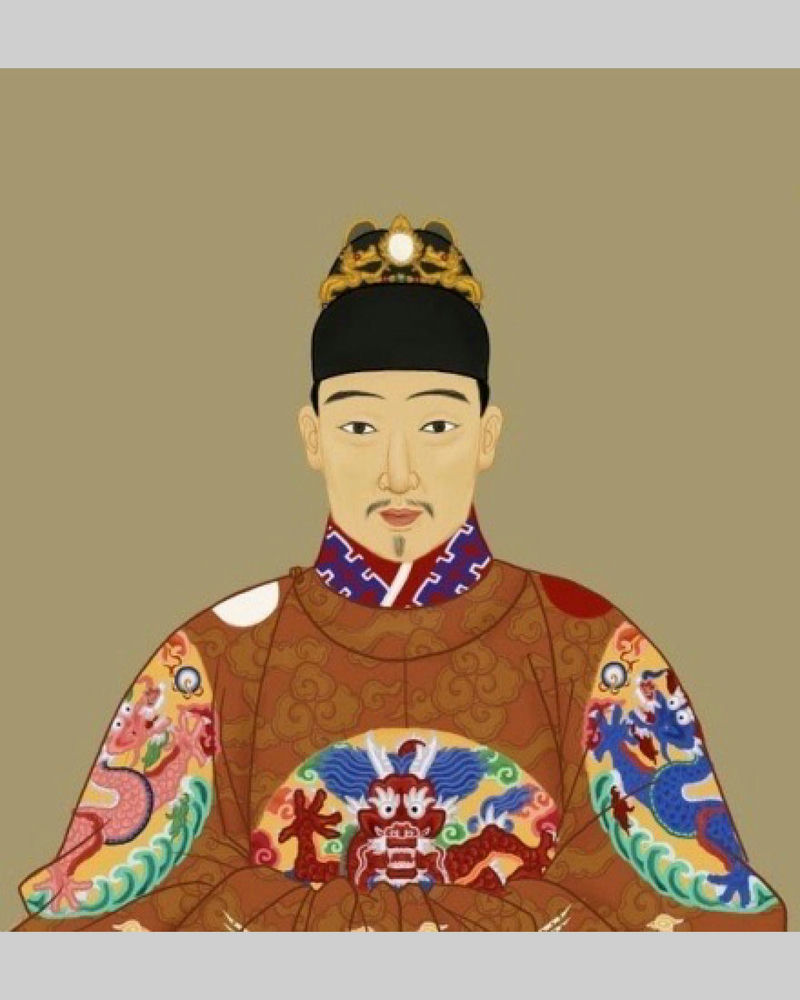
Portrait of Ch’ung-chen emperor (崇禎皇帝)
How grand is Koxinga’s achievement, and why is Koxinga regarded by the Chinese as one of their greatest national heroes? The late Ming scholar Liu Hsien-t’ing (劉獻廷) observed that Koxinga, with a single army, fought against the invading Manchu from the north even when it became a hopeless cause, recovered Taiwan as a military base, and continued the Ming dynasty for forty years, many of these years based in Taiwan. Liu believed that Koxinga’s achievements surpassed that of the other great national hero Wen T’ien-hsiang (文天祥) of the Sung dynasty, who was executed by the invading Mongols in 1283. The capital of the Ming dynasty was Peking, in the 17th year of the reign of Ch’ung-chen (崇禎) 1644, the rebel leader Li Tzu-ch’eng (李自成) sacked Peking, and Ch’ung-chen emperor committed suicide by hanging. The Prince of Fu became emperor in Nanking, south of China, his reign was known as Hung-kuang (弘光). In 1645, the invading Manchu army captured Hung-kuang emperor, transferred him to Peking where he was executed. In the same year, the Prince of Tang became emperor in Fukien province, his reign known as Lung-wu (隆武). Lung-wu emperor enobled Cheng Ch’eng-kung with the surname Chu, the same surname as the Ming emperors, hence he was called Kuo-hsing Yeh (國姓爺), meaning Lord of the Emperor’s Surname. It was phonetically translated as Koxinga. In 1646, the Manchu army entered Fukien and killed Lung-wu emperor. Koxinga’s father, Cheng Chih-lung, a pirate leader turned military leader, surrendered to the Manchu, his mother T’ien-ch’uan (田川) committed suicide. The Prince of Kuei became emperor in Kwantung, and in 1647, began the reign of Yung-li. In 1649, Yung-li emperor bestowed Koxinga the title Lord of Yen-p’ing (延平公), and in 1653, the emperor further bestowed Koxinga the title Prince of Yen-p’ing. Koxinga started fighting the Manchu in 1646, aged twenty three, the battles raged in the provinces of Fukien, Kwantung and Kiangsu. In the 15th year of the reign of Yung-li 1661, Koxinga retreated to Taiwan and recovered this territory from the Dutch. However, in the following year 1662, he became gravely ill and died at the age of thirty nine. Before he died, his words were so recorded:
“Since the nation became a leaf in the wind, I have spent sixteen years, nightly with a spear awaiting victory, tears bleeding like blood. Now I have retreated to this far and desolate place. I have floundered to uphold both loyalty and filial piety. My eyes can’t close! Heaven! Heaven! How can you banish this lonely loyalist to this very end? ”
We can imagine Koxinga’s anguish and despair in his twilight.
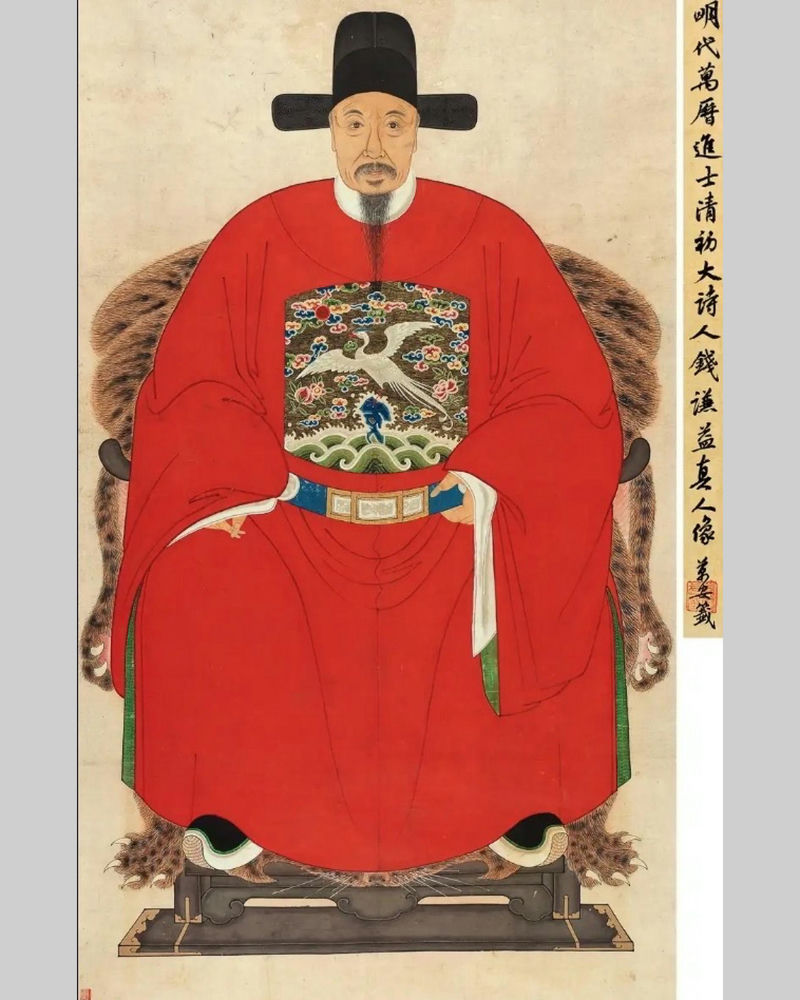
Portrait of Ch’ien Ch’ien-i (錢謙益)
Before the sacking of the Ming capital Peking in 1644, Koxinga was a student of the distinguished scholar Ch’ien Ch’ien-I (錢謙益). He was twenty one and Ch’ien gave him a literary name Giant Wood. When Ch’ien read the poems he composed, he commented:
“The style is lucid and melodious, it is not tainted by prosaic ambience. To achieve this at an early age, a true genius.”
Koxinga was endowed with both literary and military talents.
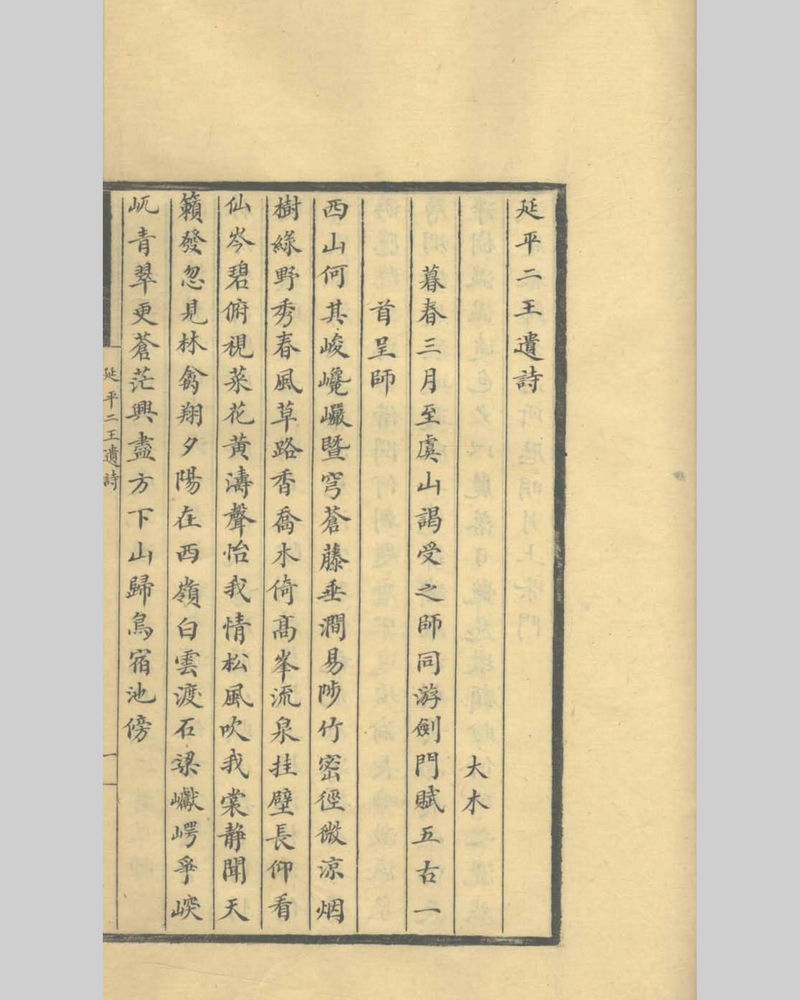
The Collected Poems of the Two Princes of Yen-p’ing
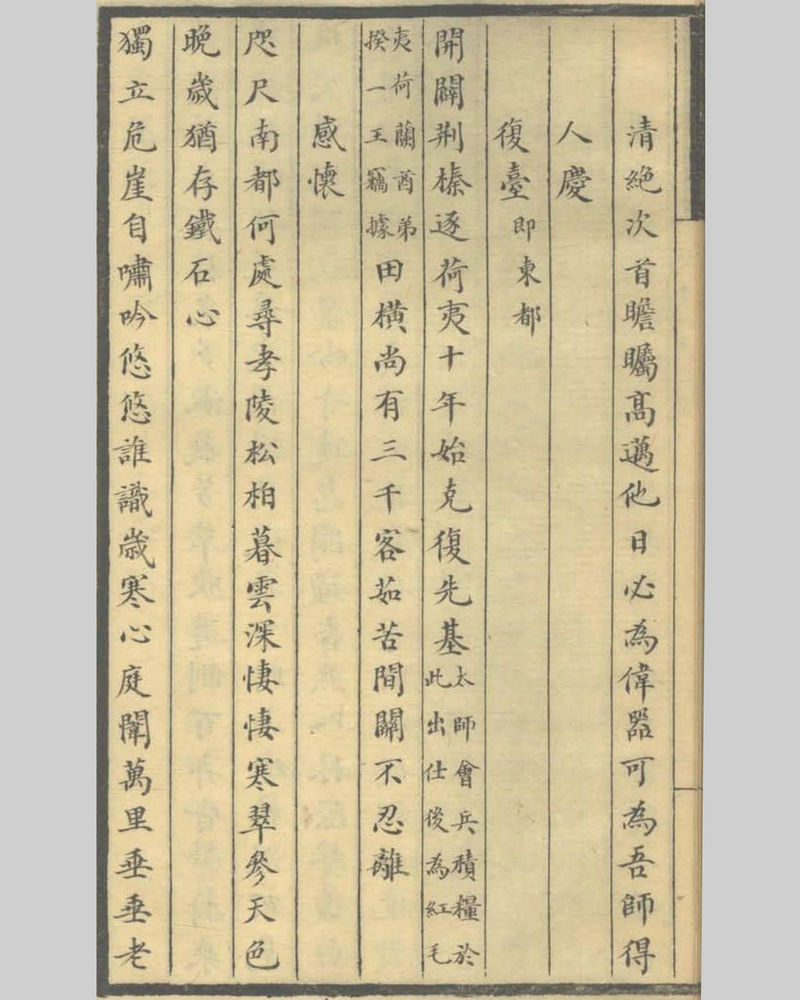
Koxinga’s poem The Recovery of Taiwan
Koxinga and his son Cheng Ching (鄭經) had their writings compiled in one volume The Collected Poems of the Two Princes of Yen-p’ing. Koxinga left behind fourteen poems, ten pieces of writings, his son Cheng Ching left behind eight poems, one epic poem, and five pieces of official writings. Despite the literary inquisitions of early Ch’ing dynasty, their writings survived through the networks of Ming loyalists and dedicated biliophiles. Amongst Koxinga’s poems, there was one titled: The Recovery of Taiwan. In this poem, he wrote that his father occupied Taiwan as a military base before the Dutch colonization, which was in the years 1621 to 1628. He also wrote that his followers were so dedicated, despite the hardships of perilous journeys and voyages, they could not take heart to leave him. From this poem, we see his trial and satisfaction in reclaiming Taiwan in 1661.
After the death of Koxinga in 1662, his son Cheng Ching and his grandson Cheng K’ei-shuang (鄭克塽) continued to honour the reign of Yung-li, despite the fact that in 1663, Yung-li emperor was himself killed by a Chinese general who surrendered to the Manchu, Wu San-Kuei (吳三桂), in K’un-ming (昆明) in Yunnan province. In June 1683, twenty two years after Koxinga died, the Ch’ing court sent a Chinese general named Shih Lang (施琅) with a 60,0000 army to attack Taiwan. Nearly 600 ships were used for the crossing. The grandson Cheng K’ei-shuang surrendered.
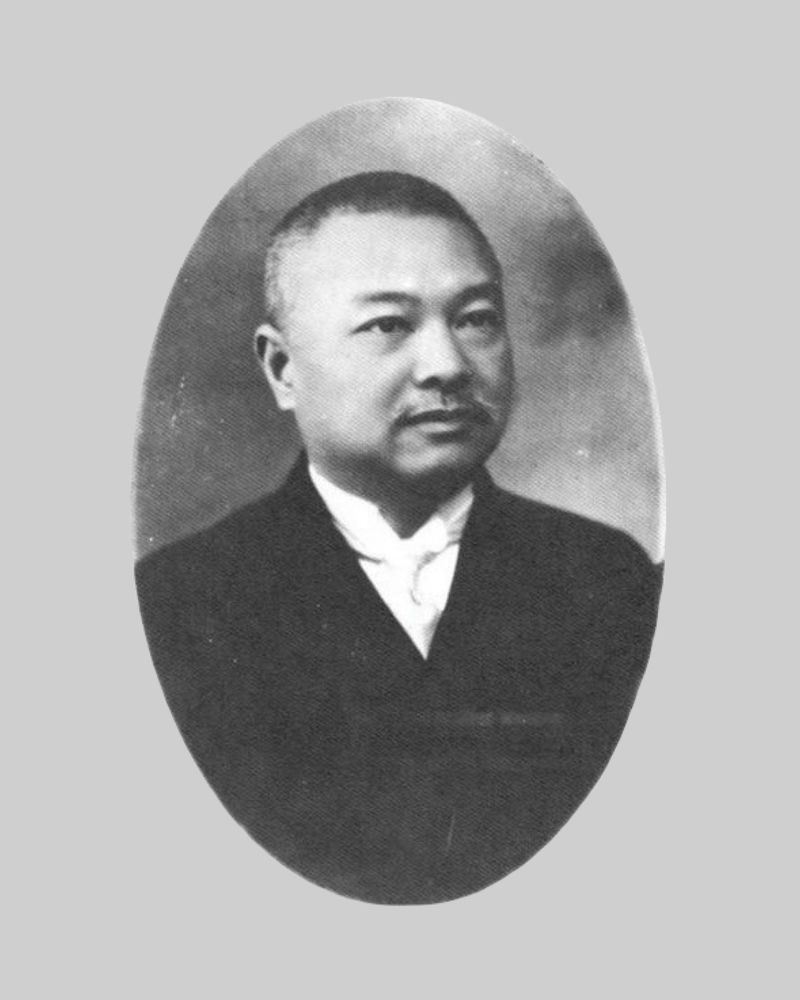
Portrait of Feng Tzu-yu (馮自由)
To fight against the Manchu, to restore mainland China, required not only a long sustainable military campaign, but also unwavering determination and perseverance. After the fall of Peking, and losing many southern battles, the Ming loyalists envisioned a long term strategy to keep the anti-Manchu flame alive. In the reign of Yung-li, during the early years of the Ch’ing dynasty, a secret society was formed with members sworn in to continue the fight against the Manchu, no matter how long the mission would take. This secret society was named T’ien-ti Hui (天地會), or Heaven and Earth Society. It did survive as an organization for centuries, and eventually played an important part in Dr Sun Yat-sen’s revolution against the Ch’ing dynasty in 1911. One of Dr. Sun’s comrades Feng Tzu-yu (馮自由) wrote in a book called : History of the Revolution before the Republic :
“Hung-men (洪門) is T’ien-ti Hui, Heaven and Earth Society. San-ho Hui (三合會) or Three Harmonies Society, Ko-lao Hui (哥老會) or Brothers’ Society are its derivatives. Three Harmonies Society is also known as San-tien Hui (三點會) or Three Points Society, it is also called Hung-shun T’ang (洪順堂) or I-hsing Hui (義興會) overseas. It is called Chih-kung T’ang (致公堂) in America, Honolulu, Philipines and Australia. Heaven and Earth Society was founded during the reign of K’ang-hsi (康熙) in the Ch’ing dynasty, not too long from the end of the Ming dynasty. The loyal officials of the Ming tried repeatedly to restore the country, and swore never to serve the Ch’ing. Waves of men followed the fallen, but they could not salvage the course of the world. A few loyalists realized that the Ch’ing dynasty was already too entrenched, the great work of restoration could not bear immediate result. Hence they attempted instead to spread nationalistic thoughts to future generations, specifically creating a secret organization, as an instrument to propagate such type of idea, and this was the beginning of the Hung-men organization. Its purpose was to oppose the Ch’ing and restore the Ming.……According to the secret annals of Hung-men, the founders of Heaven and Earth Society were Chu Hung-chu (朱洪竺), Ch’en Chin-nan (陳近南), Wan Ta-hung (萬大洪), they were suspected to be pseudonyms for Cheng Ch’eng kung (鄭成功), Chang Huang-yen (張煌言), etc. In 1904 Dr. Sun Yat-sen came to Honolulu, and knew that if he did not join Hung-men, he could not reach out to most of the comrades, so he resolved to join Chih-kung T’ang. On the day, over sixty people were sworn in, and the ritual officer conferred the title Hung-kun (洪棍) on Sun Yat-sen.”
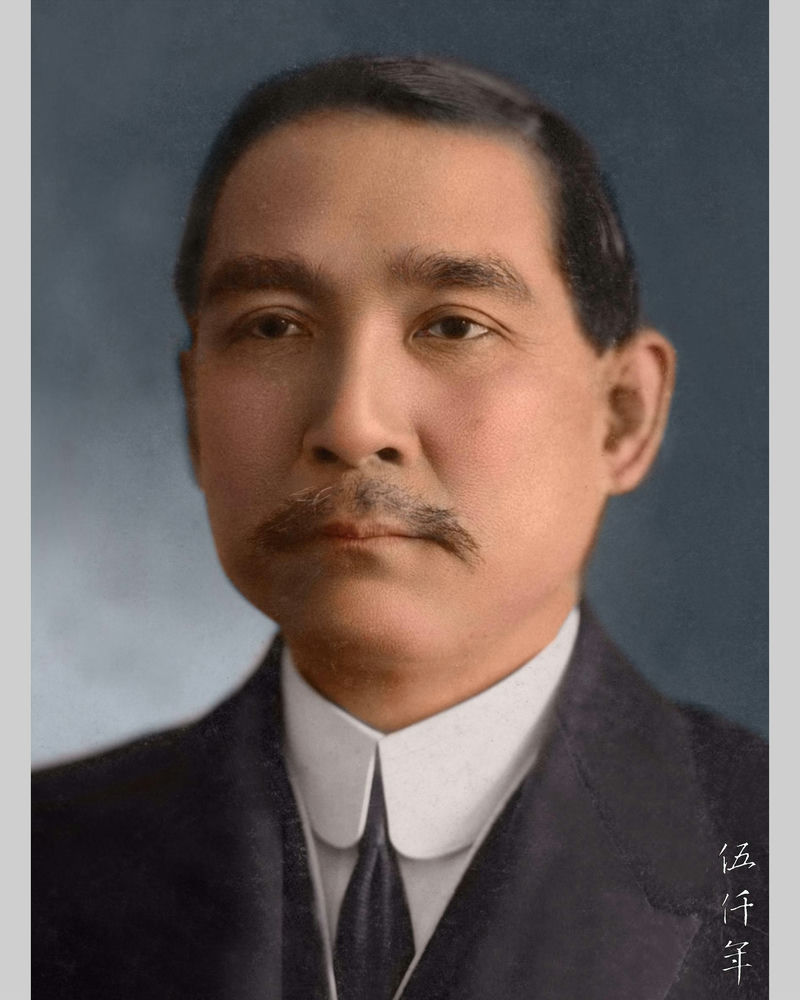
Portrait of Dr. Sun Yat-sen (國父孫中山先生)

Hung-men of China, a horizontal piece of calligraphy by K’ung Te-ch’eng (孔德成)
The title Hung-kun means leader of T’ien-ti Hui or Heaven and Earth Society. When Dr Sun launched the revolution to topple the Ch’ing dynasty and to establish the Republic of China, in the beginning he was greatly assisted by the vast organization founded by the followers of Koxinga nearly two and a half centuries ago. Heaven and Earth Society started in Fukien and Taiwan, Koxinga and his son Cheng Ching controlled the largest anti Manchu military force in these areas. We can be certain that those who first participated in Heaven and Earth Society, must overlap in some numbers with the followers of Koxinga. Some scholars also deduced that the name Ch’en Chin-nan in the secret annals of Hung-men, was Ch’en Yung-hua (陳永華), a trusted and important councel to Cheng Ching. K’ung Te-ch’eng (孔德成), the descendant of Confucius, once wrote a horizontal calligraphy piece, the first line with the words Chung-kuo Hung-men (中國洪門), Hongmen of China, the second line with the words Ta-lu Shan (大陸山), the Mainland Branch. This was presumably hung in the headquarters of Hongmen. The Mainland Branch was founded by Dr. Sun Yat-sen himself. We can see how entwined history can be, despite the distance of two and a half centuries.
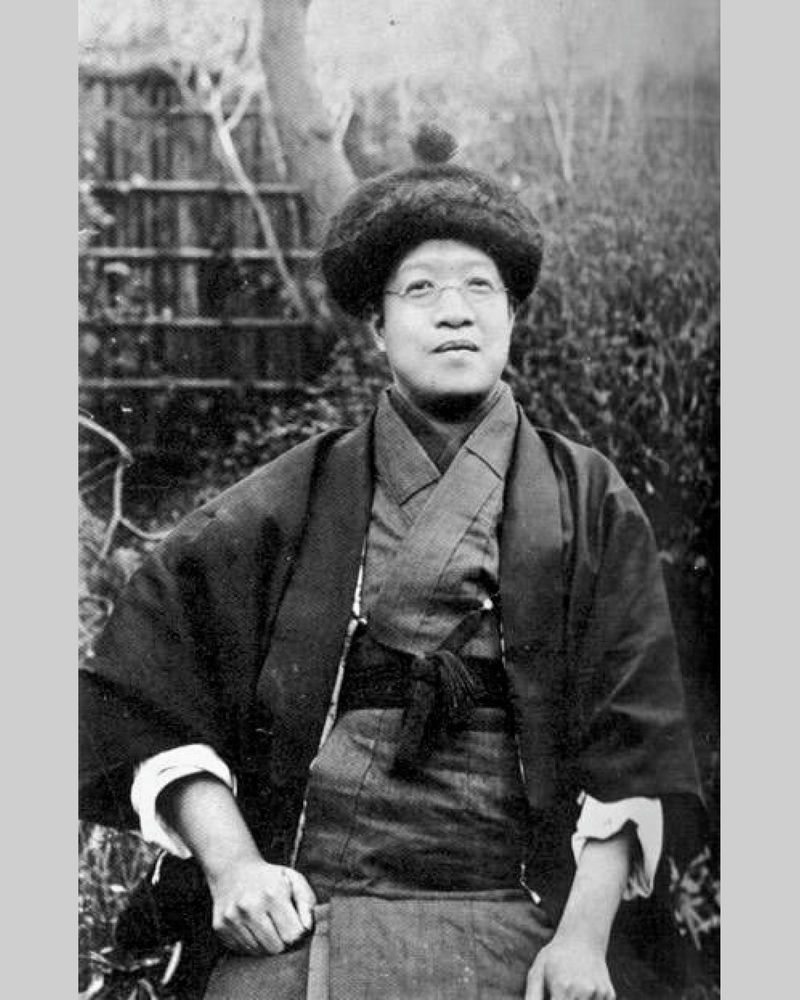
Portrait of Chang Ping-lin (章炳麟)
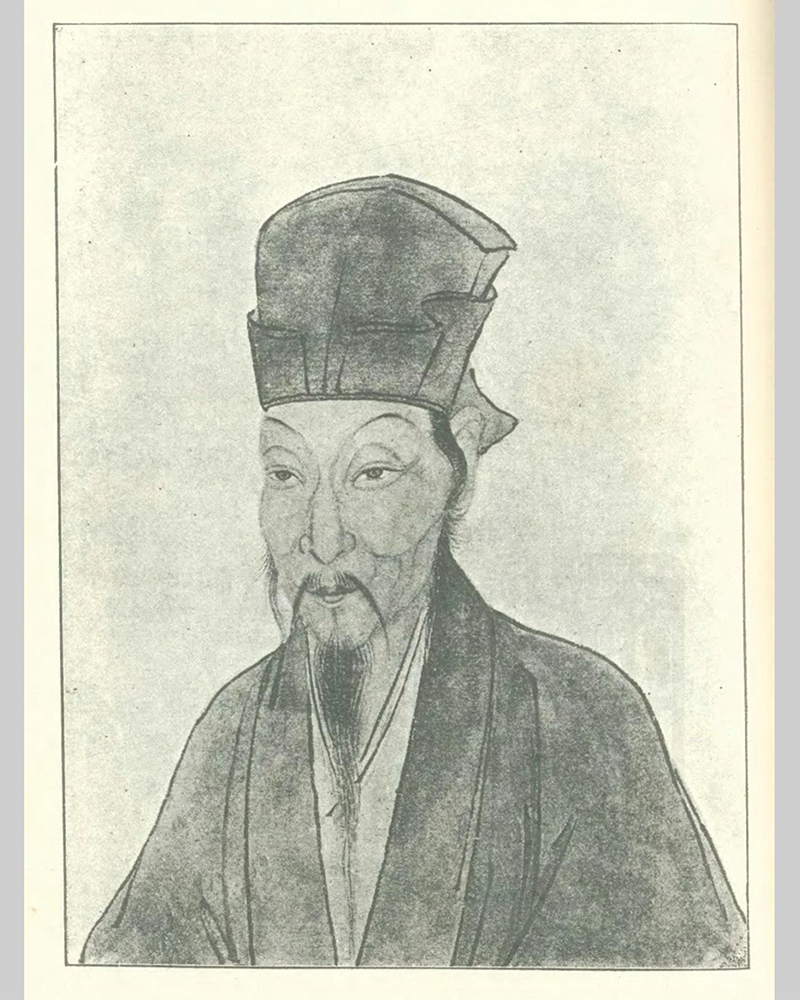
Portrait of Chang Huang-yen (張煌言)
In 1902, in the last years of the Ch’ing dynasty, another senior revolutionary Chang Ping-lin (章炳麟) attempted to hold a memorial service in Japan, with the title: The 242nd Anniversary of the Demise of China. Around the same time, Chang Ping-lin also wrote a fierce preface for the publication of the writings of Chang Huang-yen (張煌言), another famous Ming loyalist and Koxinga’s comrade in arms. The Ming loyalists became a source of inspiration for the early 20th century revolutionaries in their mission to topple the Ch’ing dynasty.
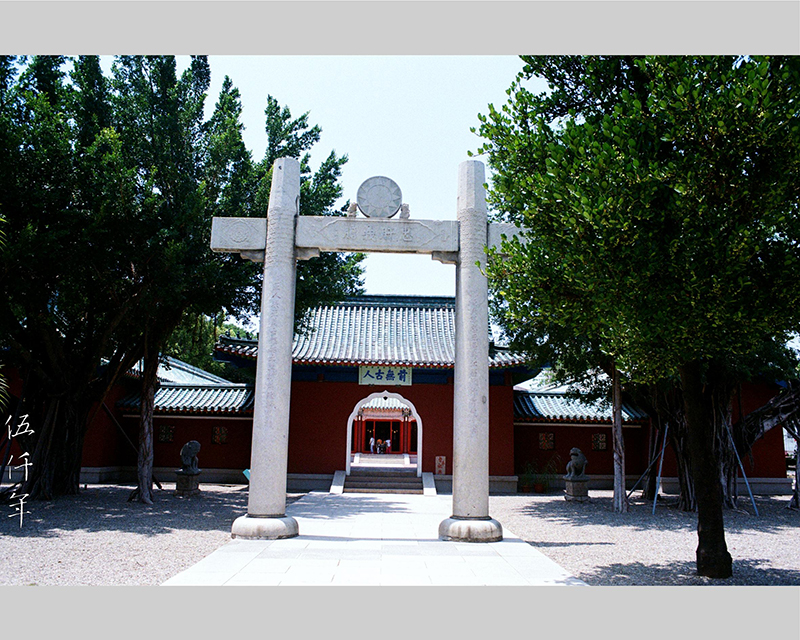
Exterior view of the Temple of Yen-p’ing Chün-wang in Tainan

Interior courtyard of the Temple of Yen-p’ing Chün-wang in Tainan

Statue of Koxinga in the main hall of the Temple of Yen-p’ing Chün-wang in Tainan
The first temple to commemorate Koxinga was built in Taiwan soon after his death, but it was only in 1875 that such a temple received official sanction from the Ch’ing court. This sanctioned temple was completed in 1875 in Tainan, known as the Temple of the Yen-p’ing Chün-wang (延平郡王祠). The title Chün-wang (郡王) was actually a demotion of Koxinga’s originally title Wang (王), Prince. It was a move to underline the power and superiority of the conqueror.
In 1963, the government of the Republic of China rebuilt the temple in the northern architectural style to emphasize the importance of this temple. Inside the temple, there are many engraved calligraphy couplets and horizontal plaques written by eminent Chinese in modern history.
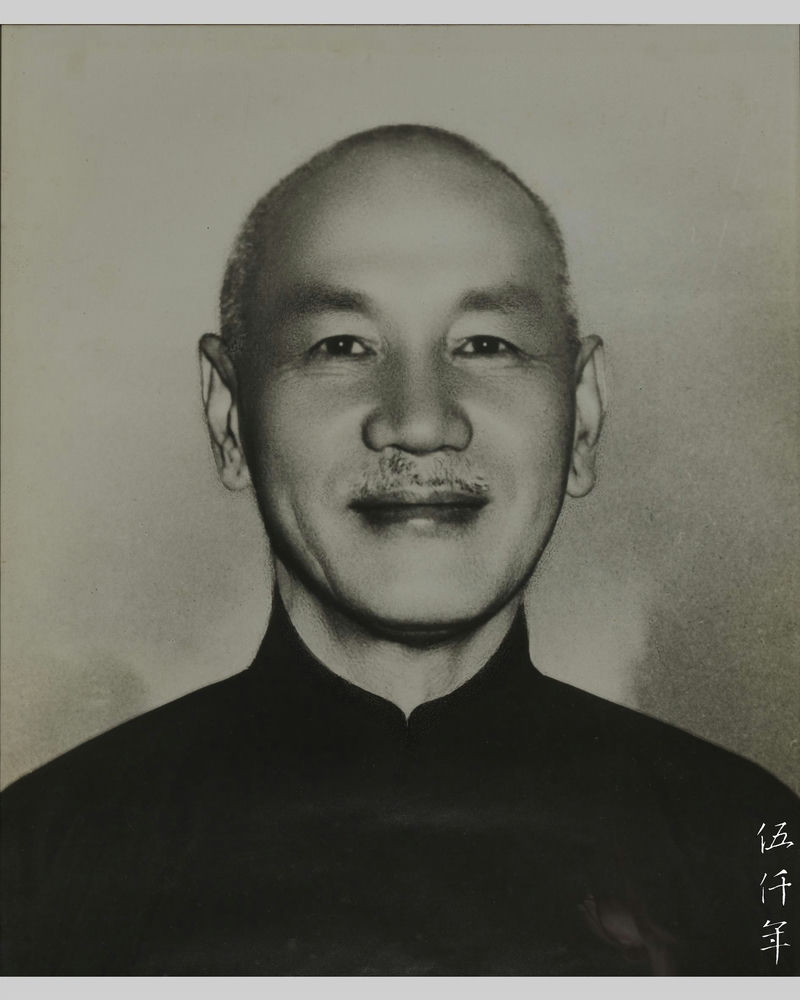
Portrait of President Chiang Kai-shek (先總統蔣介石先生)

To Reinvigorate China, a horizontal piece of calligraphy by President Chiang Kai-shek
These literary compositions also demonstrated the sentiments of their times, from the jubilation surrounding the Japanese surrender in 1945, wherby Taiwan was again recovered as Chinese territory, to the abomination towards the communist insurrection in 1949, whereby the central government of China withdew to Taiwan. An example is a horizontal plaque written by President Chiang Kai-shek in 1950, Chen-hsing Chung-hua (振興中華), To Reinvigorate China, a testimony to Koxinga’s ambition and achievements, but also an allusion to that of his own government.
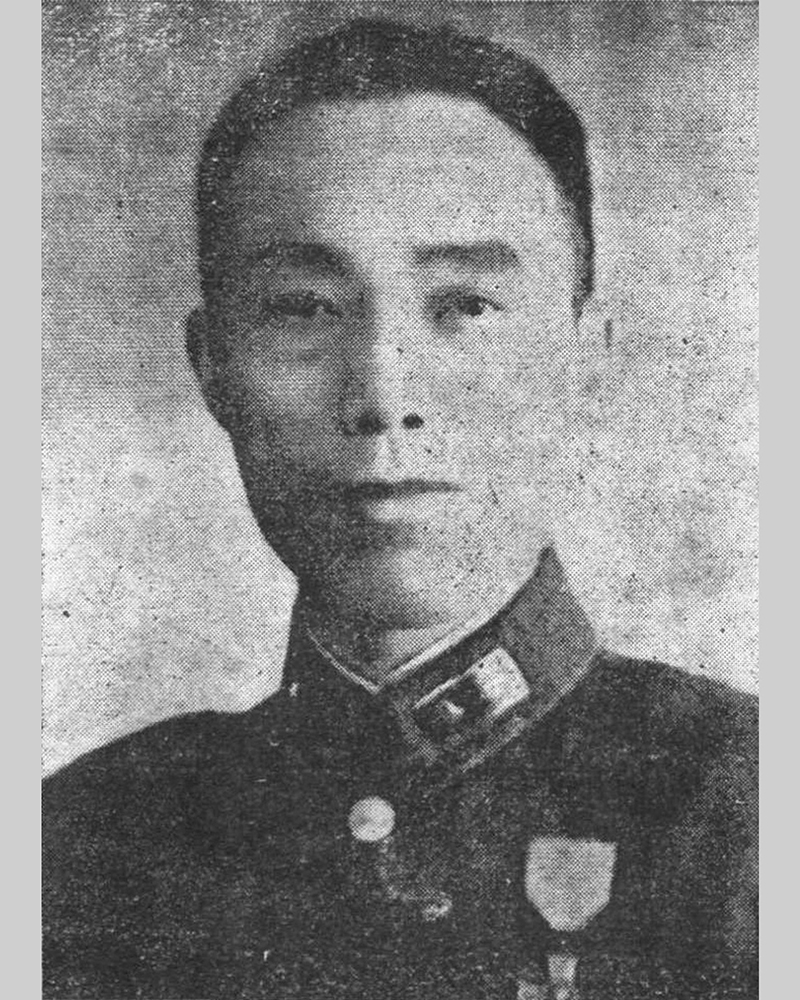
Portrait of Wang T’ung-yüan (王東原)

Calligraphy couplets carved on wood by Wang T’ung-yüan

Portrait of Chu Chiu-ying (朱玖瑩)

Calligraphy couplets carved on wood by Ch’u Chiu-ying
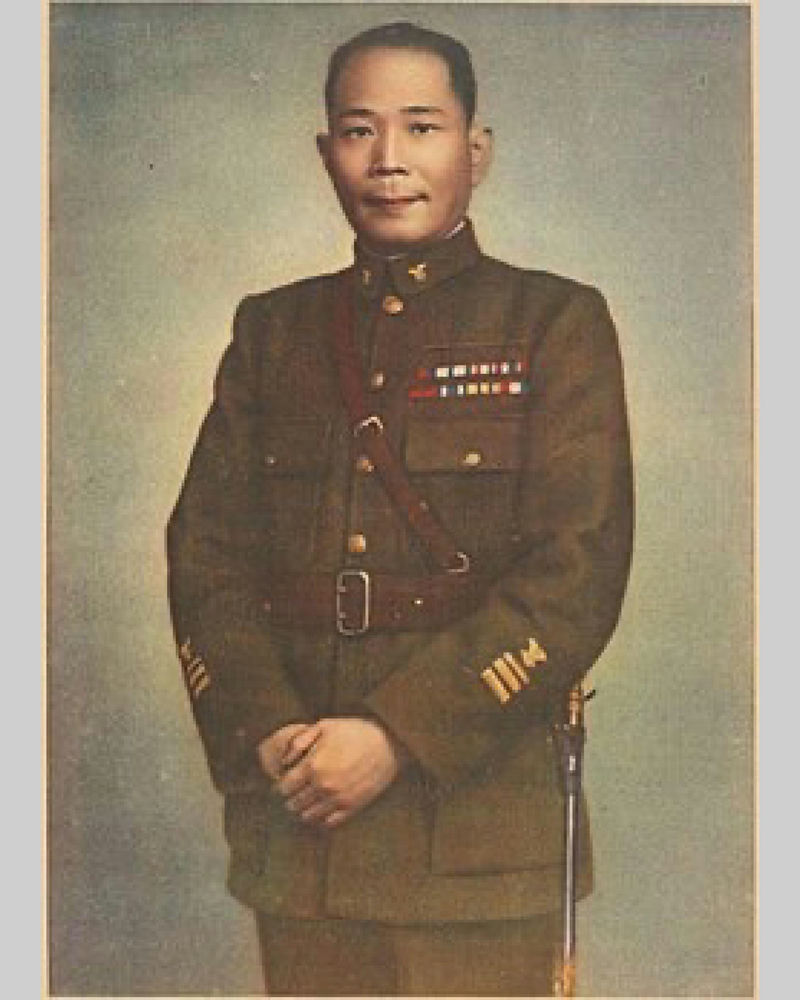
Portrait of Chou Chih-jou (周至柔)
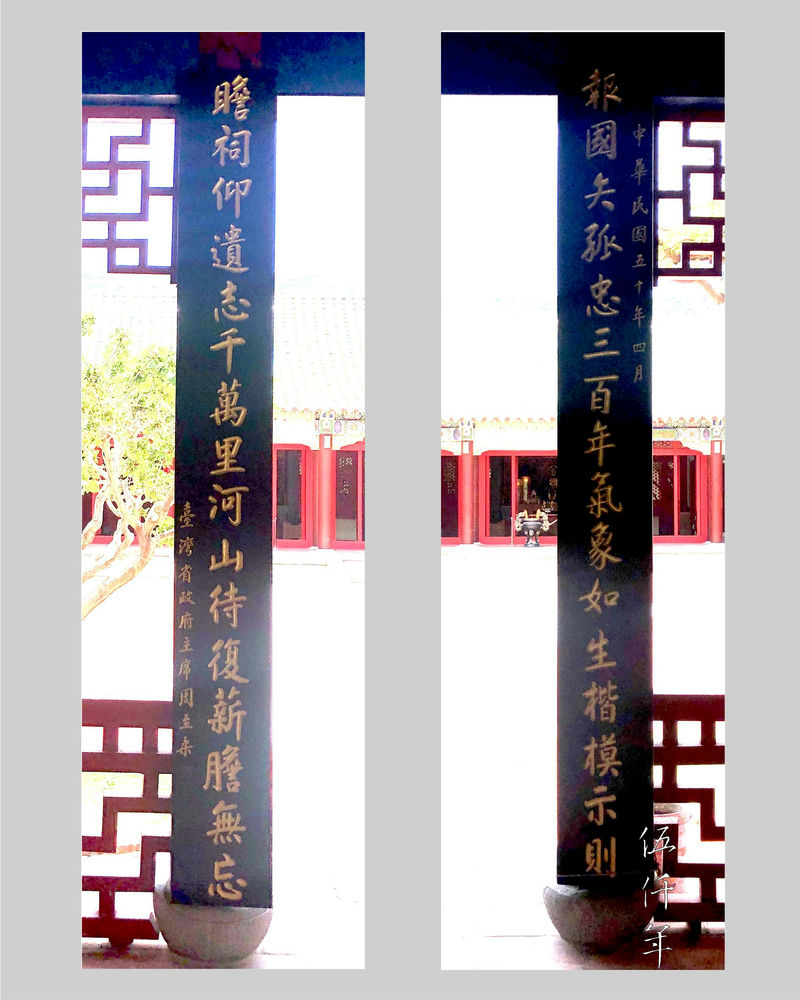
Calligraphy couplets carved on wood by Chou Chih-jou
Sixty years ago, in 1961, the government of the Republic of China regarded the commemoration of Koxinga’s 300th anniversary of the recoverey of Taiwan an important state event. On 29th April a commemoration ceremony was held in the Koxinga Temple in Tainan, attended by government officials representing all branches and departments. Eighteen large public events were also held in Tainan as part of the festivities. Three books were then published, interesting and informative in different ways.
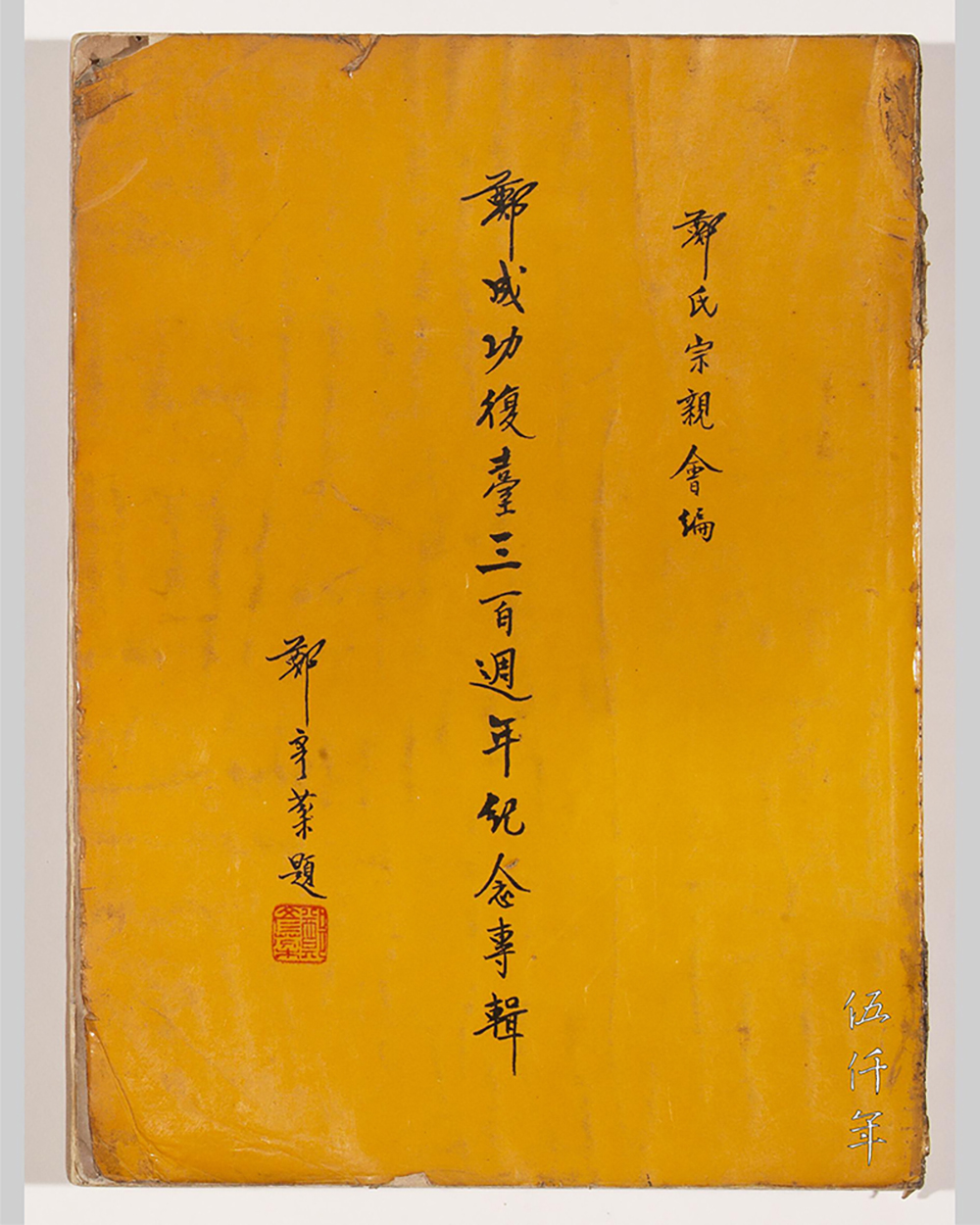
Front cover of Special Issue of the 300th Anniversary of the Recovery of Taiwan by Koxinga, published in 1961

Inside page with photographs of commemoration ceremony
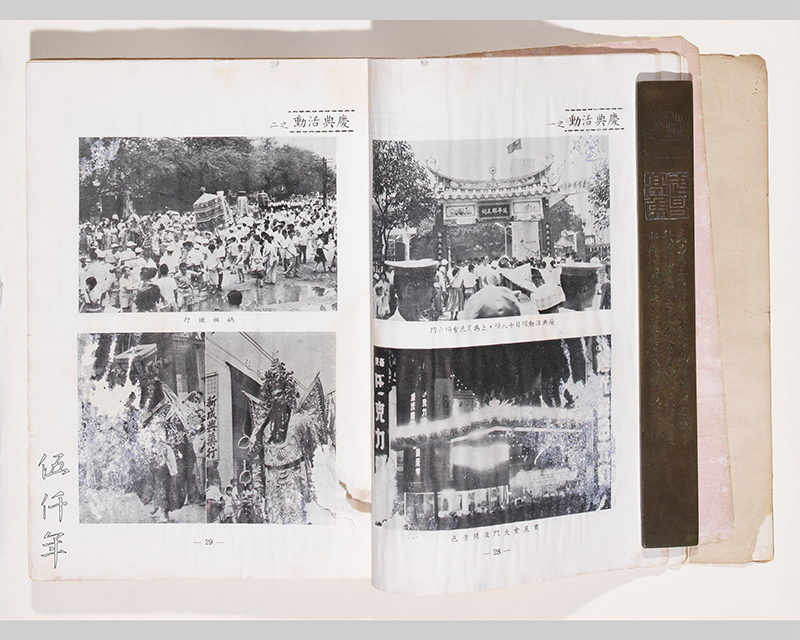
Inside page with photographs of commemoration activities
The first book Special Issue of the 300th Anniversary of the Recovery of Taiwan by Koxinga contains many photographs of the commemoration ceremony and the many public events.
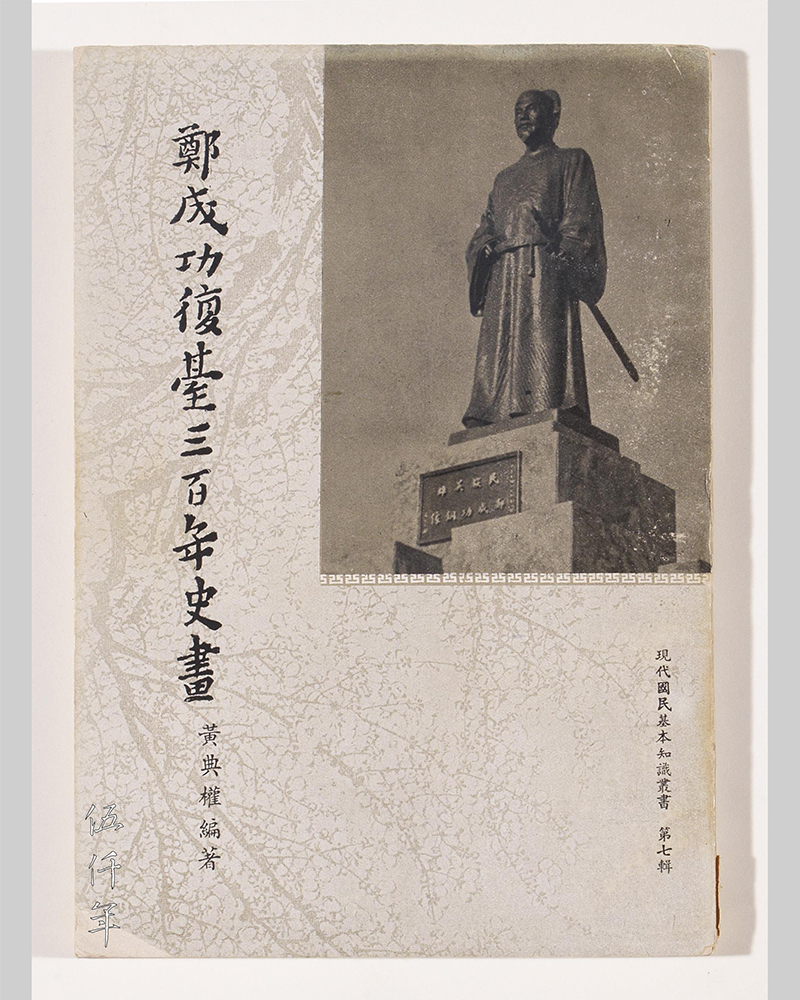
Front cover of Pictorial History of the 300th Anniversary of the Recovery of Taiwan by Koxinga, published in 1961
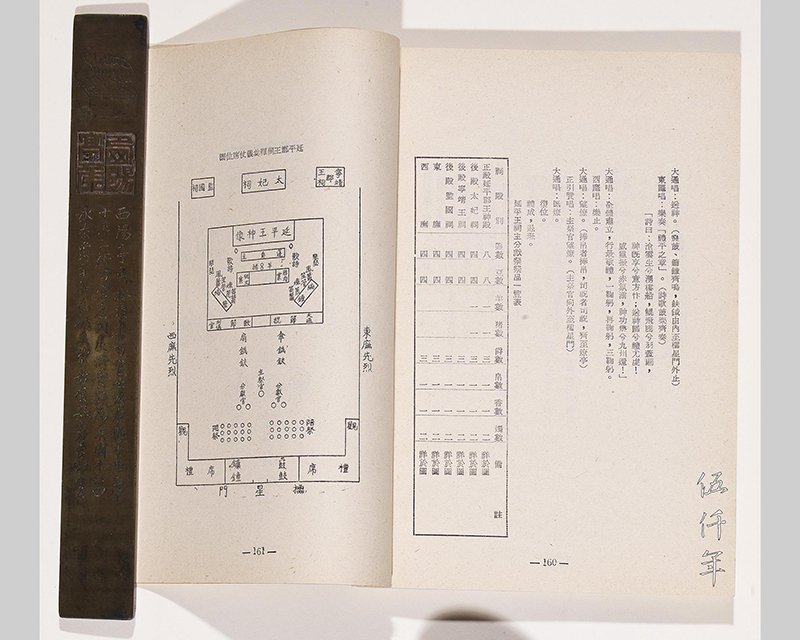
Inside page with plan of commemoration ceremony

Inside page with plan of table setting for ritual offerings to Koxinga and plan of table setting for ritual offerings to the mother of Koxinga
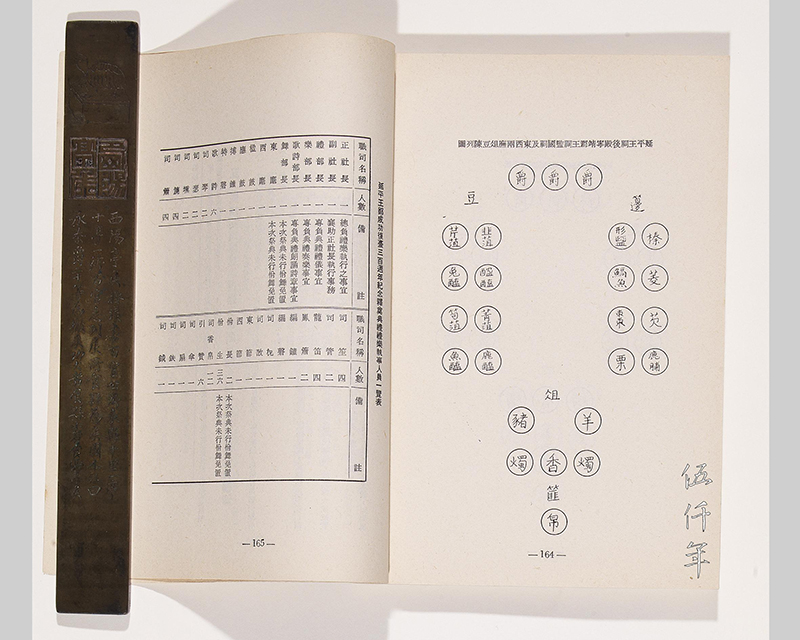
Inside page with plan of table setting for ritual offerings to the last imperial descendant of the Ming dynasty, the son of Koxinga and the generals of his army
The second book Pictorial History of the 300th Anniversary of the Recovery of Taiwan by Koxinga has some illustrations of the placements of the ancient musical instruments used in the commemoration ceremony, as well as the placements of the ritual offerings to Koxinga, his mother, and the martyrs in his military units.
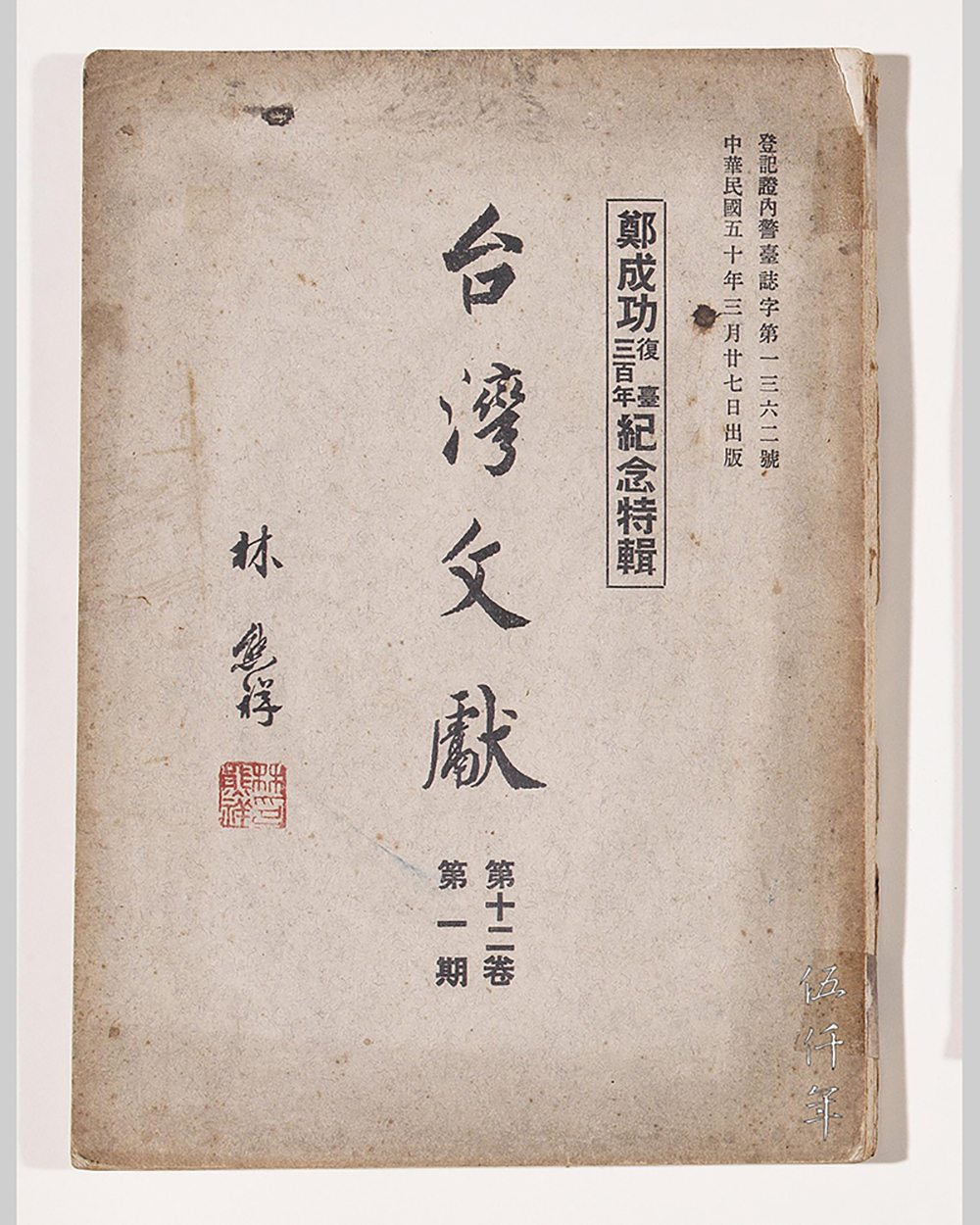
Front cover of Taiwan Historical Documents: Special Issue of the 300th Anniversary of the Recovery of Taiwan by Koxinga, published in 1961
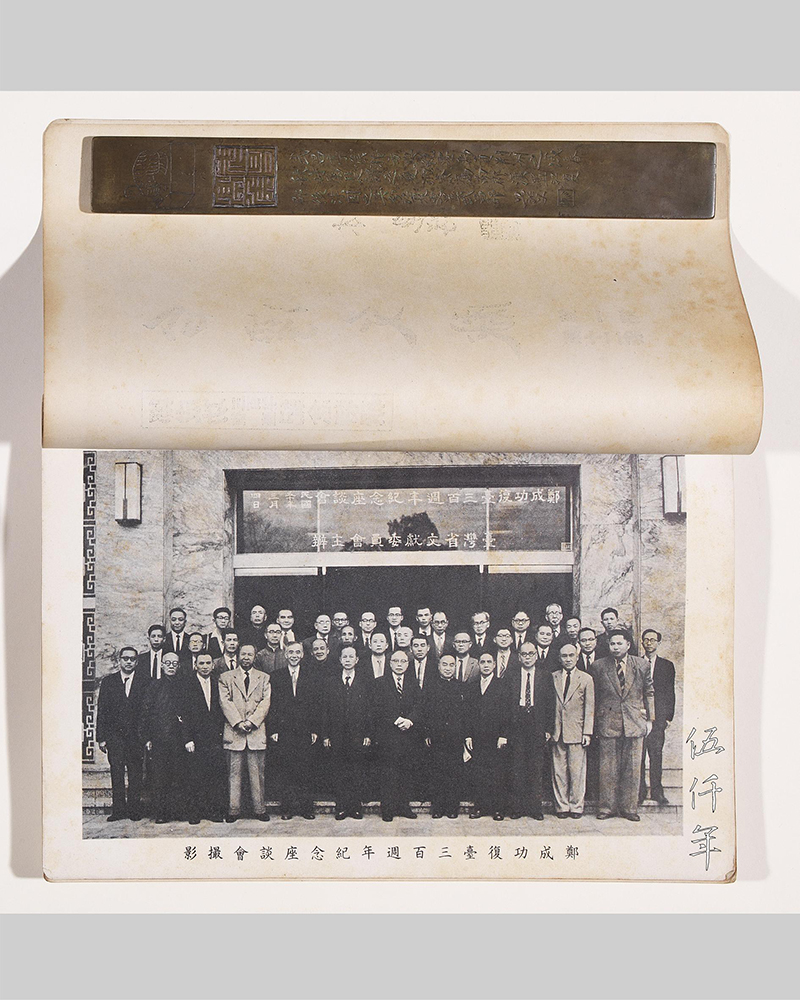
Inside page with group portrait of scholars attending the Symposium on Koxinga, 1961
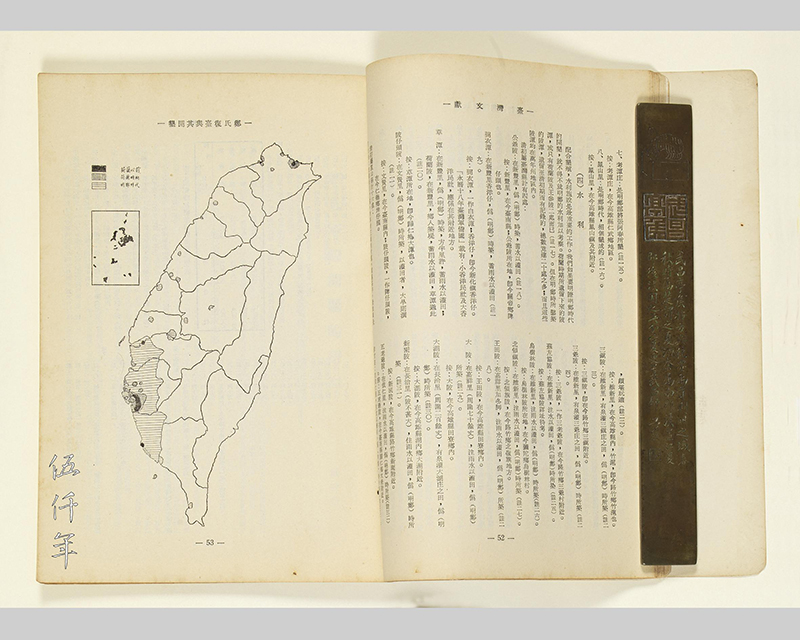
Inside page with map of Taiwan depicting the area developed before and during the Dutch colonization, as well as during the reigns of Koxinga and his descendants
The third book Taiwan Historical Documents: Special Issue of the 300th Anniversary of the Recovery of Taiwan by Koxinga is a record of an academic symposium on Koxinga. There are two compelling illustrations of a group photograph of the participants and a map of Taiwan, the map depicts the area developed before the Dutch colonization, during the Dutch colonization, and during the reigns of Koxinga and his descendants. From this map, we can clearly see the political, social and economic contributions Koxinga and his descendants made to the development of Taiwan.
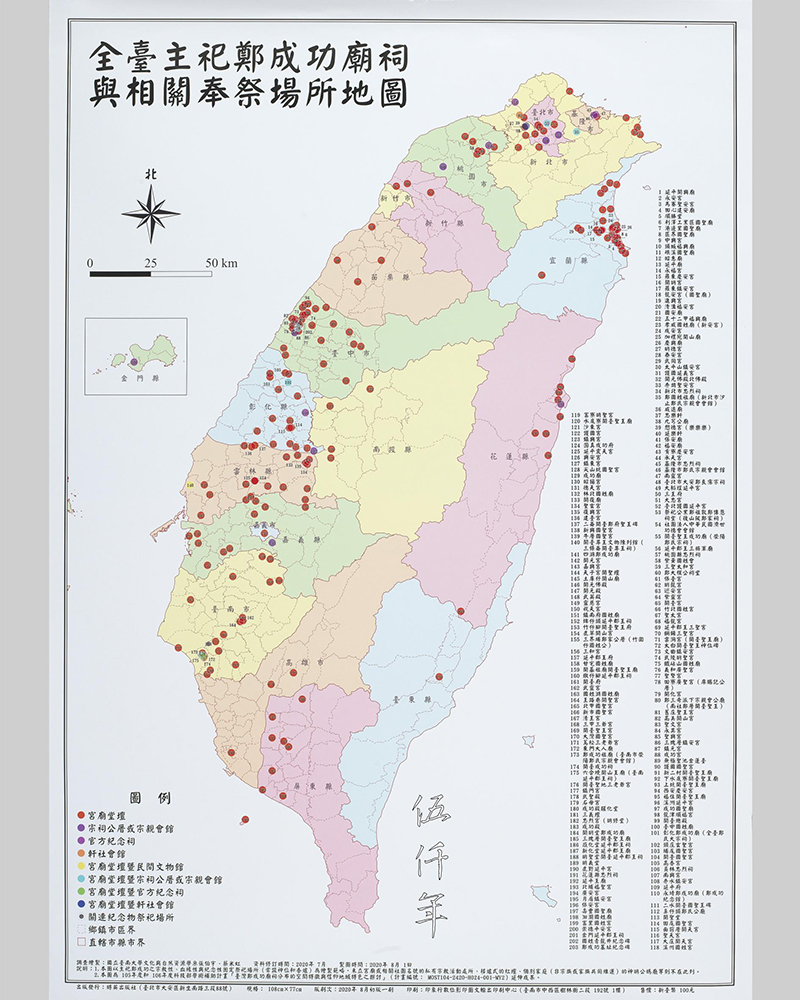
Map showing all commemoration sites and buildings of Koxinga in Taiwan
I have been given a recent map made by Professor Chang Po-yü (張伯宇) and Professor Tsai Mi-hung (蔡米虹) of Tainan University, showing all the commemoration sites and buildings of Koxinga in Taiwan. Two hundred and three sites and buildings were marked on this map. Koxinga is more than a popular hero here, he is also a religious figure, a god.
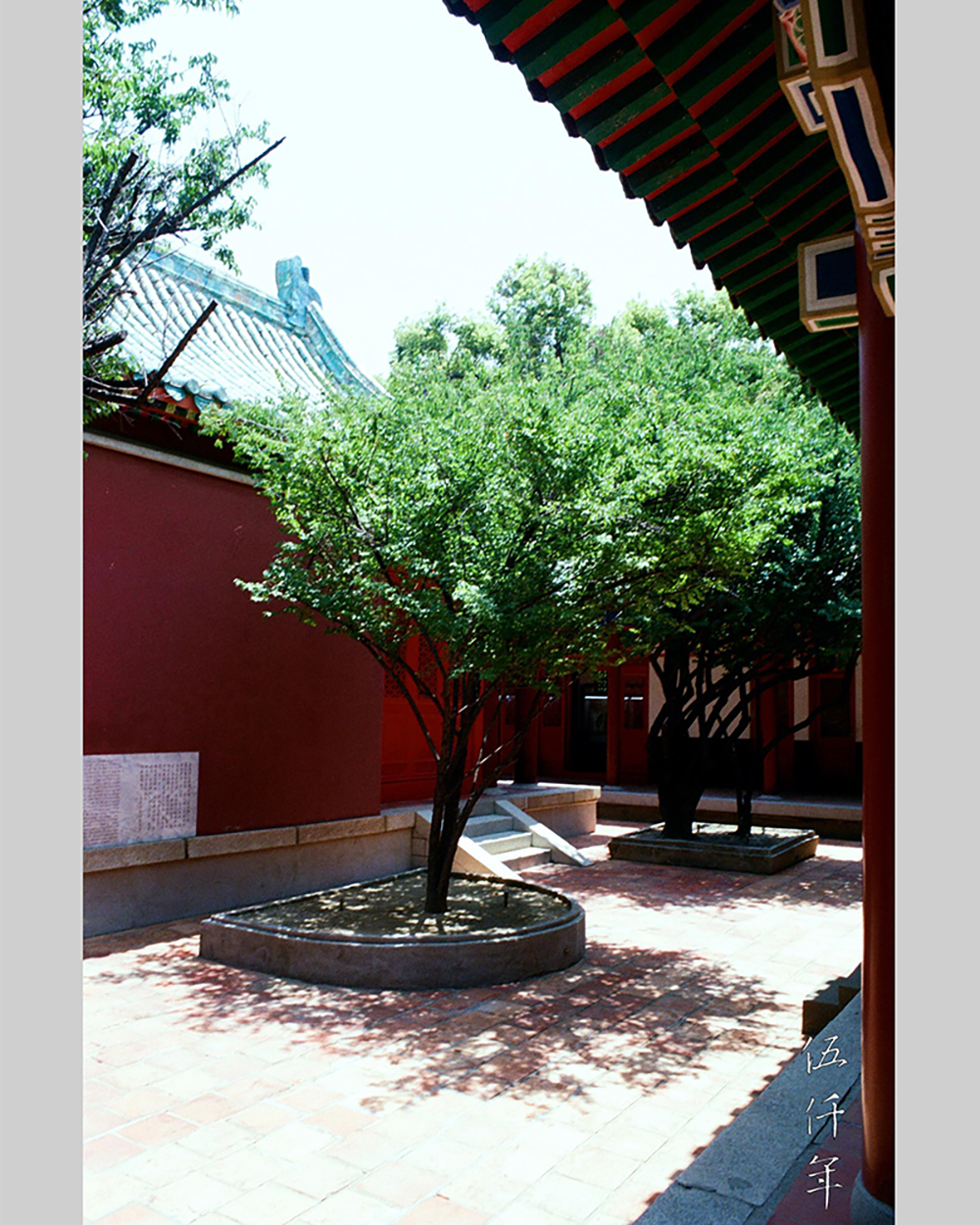
Prunus tree planted by Koxinga in the Temple of Yen-p’ing Chün-wang in Tainan
In the Koxinga Temple in Tainan, behind the Hall of Koxinga, and in front of the Hall of Koxinga’s mother, there is a prunus tree, by legend, planted by Koxinga. Prunus has deep cultural significance for Chinese, representing many Confucian virtues, righteousness, moral courage, nobility and inner strength. Since Koxinga himself was already identified with many Confucian virtues, his act of planting a prunus tree, sanctified the tree as the perfect Confucian symbol.
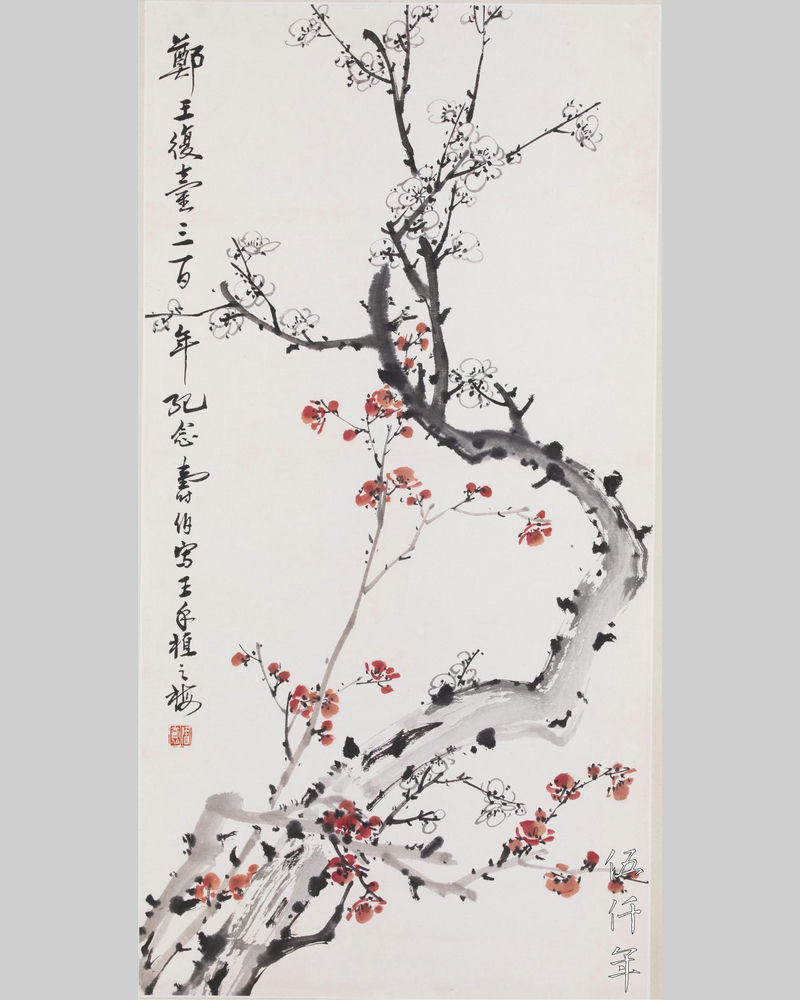
T’ao Shou-po (陶壽伯) painted the prunus tree planted by Koxinga
Sixty years ago, in this spirit of homage, the artist T’ao Shou-po (陶壽伯) painted the prunus tree planted by Koxinga, and wrote on the painting:
“To commemorate the recovery of Taiwan three hundred years
ago by Prince Cheng. Shou-po (壽伯) painted the prunus planted by the hands of the Prince.”
Sixty years from now, in the 7th chia-tzu, or even one hundred and twenty years from now on, in the 8th chia-tzu, when future generations confront their own trials and tribulations, the moral universe of Koxinga, can continue to inspire and councel.

Anping gunpowder vessel and iron cannon of late Ming dynasty
